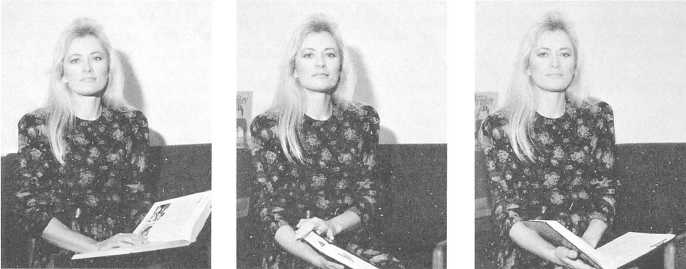302.306
Figure 5-27.–Effects of direct, diffused and bounce flash.
situations where there is a 8- to 10-foot-white ceiling.
Your photographs of reenlistments, frockings, awards,
and so forth, will have a more pleasing effect.
Most bounce flash pictures are made with the light
directed at the ceiling, either above the photographer or
above the subject, or somewhere between. A silhouette
effect can be produced by bouncing your flash off the
ceiling behind the subject. To accomplish this, aim your
flash unit so most of the light bounced off the ceiling
falls on the background behind the subject and calculate
the exposure for the background.
For the flattest bounce light, try bouncing the light
off a wall behind the camera. With this lighting, you will
have practically no shadows. Here, you have to calculate
your exposure based on the flash-to-wall-to-subject
distance.
For side lighting, bounce your flash off a wall to the
side of your subject. This type of lighting helps add a
feeling of three dimensions to your picture.
For the best control, use a large reflector designed
for bounce lighting. Special-made reflectors are
available that are lightweight, compact, and portable.
For closeup work, the best bounce reflector is about 3
by 4 feet square. For full-length subjects, try a reflector
about 6 by 6 feet.
To determine the exposure for bounce flash using
the manual mode on your flash, you must determine the
flash-to-ceiling-to-subject distance and determine your
f/stop and then open the aperture two additional f/stops.
The two additional f/stops are added to compensate for
loss of light due to scattering and absorption by the
reflecting surface.
When an automatic flash is used in the automatic
mode, it is not necessary to open up two f/stops. The
sensor automatically cuts off when the proper amount
of light is reflected from the subject to the flash unit.
When the ceiling is high or dark, a compensation to
the basic exposure may be required. For effective use of
the bounce-flash technique, a considerable amount of
practice is required. As with any flash photography
technique, identify any areas or surfaces that may be
potential problems. Remember, one of the basic
principles of reflected light is that the angle of incidence
is equal to the angle of reflectance. Highly polished or
glass surfaces should be considered before the subject
is photographed. Items, such as windows, glass
tabletops, glass framed photographs and polished metal,
can cause glare or a “hot spot” in your photograph.
When you are using bounce lighting techniques, “hot
spots” of vertical surfaces are normally prevented,
because the light source striking the surface is angled
from above or the side; however, when you are using
bounce lighting techniques, horizontal surfaces, such as
glass coffee tables and overhead light fixtures, can cause
a strange diffused lighting pattern in the photograph.
When using a single, on-camera flash, experiment
with direct, diffused, and bounce-flash techniques and
5-33


